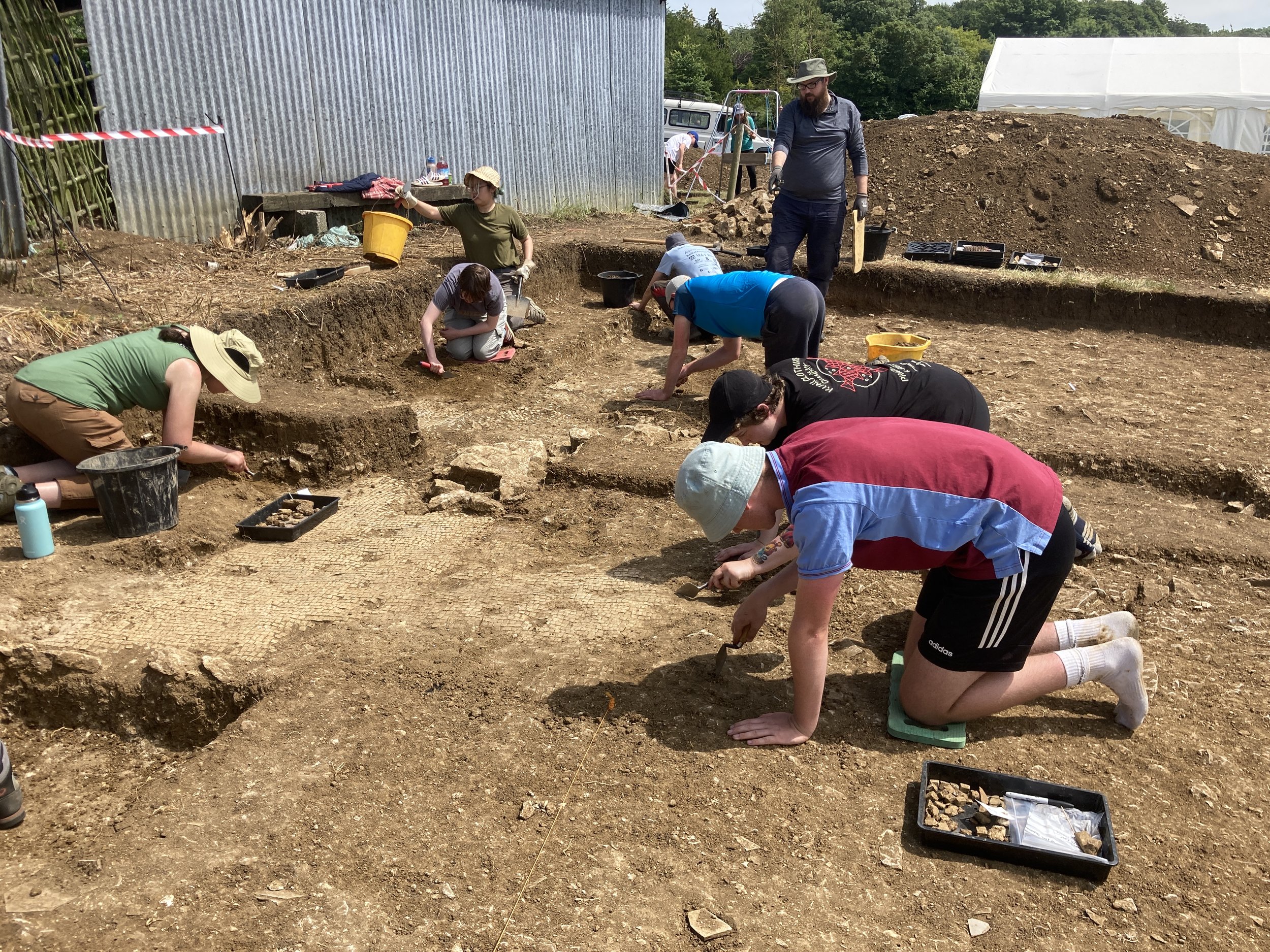Hinton St Mary, Sturminster Newton, Dorset
Fieldwork was conducted at Hinton St Mary in Dorset during the summers of 2021 and 2022, as part of a collaborative project between Albion Archaeology, Barbican Research Associates and The British museum, to investigate the site of the iconic late-Roman mosaic pavement discovered there in 1963.
Because of the huge significance of the discovery – the bi-partite mosaic has what some consider might be one of the earliest depictions of Christ in its central roundel, and a scene of Bellerophon and the Chimera in the smaller room – more trenches were carried out in 1964 by Kenneth Painter from the British Museum. Painter suggested that the room in which the mosaic was located had been part of a much larger building complex, consisting of 3 ‘wings’ around a central courtyard, which was a relatively common high-status villa type in late Roman Britain. Painter’s trenches, however, failed to properly establish the nature of the archaeological remains, or indeed the history of occupation at the site, and although further excavations were planned, unfortunately these never came to fruition.
Only the central roundel is currently on display at the British Museum (in the Weston Gallery of Roman Britain) and the Museum is seeking to find a solution to the long-term display of the mosaic in its entirety. This brought into sharp focus the need to better understand its archaeological and historical contexts, and so in 2019 a project proposal for an evaluation excavation at Hinton St Mary – a Scheduled Monument – was put together (the work should have taken place during the summer of 2020, but was postponed because of the covid-19 pandemic). A 4-week evaluation finally took place in August and September 2021, opening 6 trenches in the scheduled area to investigate the buildings putatively identified by Painter and the geophysics.
Trench 1 intersected with the 1965 trench to lift the mosaic, but also located the lower courses of a wall bonded to the foundations of the mosaic room that extended for at least 14 m to the southeast. This was probably the building’s front wall, possibly a colonnaded portico with a step from a courtyard to the north, confirming that the mosaic existed as part of a larger building (though almost certainly narrower than previously believed), which had been built in a single episode. Initial examination of the coins and pottery suggests that this took place no earlier than the late 3rd century and that occupation continued at least to the end of the 4th century.
The other five trenches excavated were sited on the downward slope to the south-west of the mosaic, positioned to examine the buildings Painter had identified as possible wings. No evidence of villa-type buildings or structures was revealed anywhere. Only Trenches 3 and 6 produced evidence for Roman structures, but in both cases this consisted of solid stony layers that give the impression of yard surfaces, or the hard-wearing floors within ancillary buildings. A covered drain contemporary with these layers was excavated in Trench 3 and thick mortar deposits in Trench 6 suggest an internal space of some kind in this part of the field, but no evidence for masonry walls was found in any of the trenches. Nor was there any sign of significant ploughing that might have removed walls and their footings.
The archaeological remains encountered in the trenches show that Painter’s reconstruction of the plan of the buildings is incorrect and needs to be reconsidered (indeed, it is no longer certain that the mosaic was part of a building we can safely call a ‘villa’).
The fieldwork took place in conjunction with students from Cardiff University/Prifysgol Caerdydd. Many of these students were first-years for whom this was their first opportunity to participate in an excavation and they were assessed for the practical component of their university courses. The presence of experienced commercial archaeologists meant that there was always someone on hand to offer advice or answer questions. Those graduating in the last week of the project perhaps benefited most from the presence of archaeologists from a broad range of sectors. Besides the additional experience they gained while excavating, they were also able to learn more about the profession they would soon enter.
The archaeology too benefited from the presence of a number of professionals. Although the students and volunteers did an excellent job, in reality, most had little fieldwork experience. This cannot compare to the experience gained form years of working as a professional archaeologist. Having professionals working alongside the students means the work is more carefully monitored and enables the students to undertake a range of tasks that require a little more supervision. Participation in a training excavation also brings huge benefits to a commercial organisation. The staff involved get to work on the kind of sites rarely seen in commercial archaeology (a scheduled monument with a mosaic in this case), to engage with the public and school children (not always possible on a commercial excavation), and to meet and work with various specialists from academia (perhaps creating future opportunities for collaboration and fostering working relationships outside the usual spheres).
This was a collaborative project involving Albion Archaeology, Barbican Research Associates and The British Museum, with undergraduates archaeologists from Cardiff University, who were trained in fieldwork techniques, forming the bulk of the project team (see image). The directors were Mike Luke (Albion), Peter Guest (Barbican) and Richard Hobbs (British Museum).
Summary by Mike Luke, Kathy Pilkinton, Matevž Grošelj and Hester Cooper-Reade





